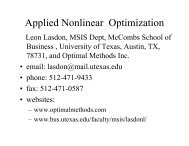[PDF] ALIO Back Matter
[PDF] ALIO Back Matter
[PDF] ALIO Back Matter
Create successful ePaper yourself
Turn your PDF publications into a flip-book with our unique Google optimized e-Paper software.
SA08<br />
■ SA08<br />
Aula 355- Third Floor<br />
Decision Support Systems<br />
Contributed Session<br />
Chair: Sasa Bosnjak, Professor, University of Novi Sad, Faculty of<br />
Economics Subotica, Segedinski Road 9-11, Subotica, 24000, Serbia-<br />
Montenegro, sasabosnjak1996@gmail.com<br />
1 - Cotton Stalks Biomass Utilization for Cement or for Bioethanol<br />
Production? A LCIA Approach<br />
Costas Pappis, University of Piraeus, Department of Industrial<br />
Management and Technology, 80 Karaoli and Dimitriou Street,<br />
18534, Piraeus, Greece, evpet@otenet.gr, Evangelos Petrou<br />
Cotton stalks may be used, apart from bioethanol production, in its raw form as a<br />
fuel in production systems. In this paper a case study is presented, where the results<br />
of a Life Cycle Impacts Assessment implemented on a particular supply system<br />
involving cement works in Greece are assessed. These results are compared for<br />
decision making purposes with the impacts resulting when cotton stalks are used for<br />
bioethanol production. A powerful software is used for the realization of this LCIA<br />
study.<br />
2 - HERCULES Decision Support System Applied to Public Transport<br />
System: Prototype and Case Study<br />
Diego Branca, Universidad de Palermo, Mario Bravo 1050 - Piso 10.<br />
AIGroup, CABA, Argentina, dbranca@gmail.com, Santiago Bosio,<br />
Gustavo Janezic, Juan Pablo Musella, Francisco Milano, Daniela<br />
López De Luise, James Stuart Milne, German Ricchini, Paula Schuff<br />
The aim of this research is the implementation of a DSS based on several criteria:<br />
macro, microeconomical, socio-economical, socio-political and specific<br />
industry.Variable selection and management related to mentioned models criteria<br />
are studied. It is also analyzed meta-question design and its specific questions at the<br />
moment to define system capacities.<br />
3 - Multicriteria Model to Improve the Use of Performance Evaluation<br />
Instruments with Focus on Indicators<br />
Edilson Giffhorn, MSc. in Production Engineering, Federal University<br />
of Santa Catarina, UFSC - Brazil, Rod. Amaro António Vieira, 655,<br />
Apt.106E, Florianópolis, 88034-101, Brazil,<br />
edilson.giffhorn@gmail.com, Leonardo Ensslin, Sandra Rolim<br />
Ensslin, William Vianna<br />
The aim of this paper is to present a process for improving the way to use the<br />
instruments of performance assessment on their way to identify, organize, measure<br />
and use the Performance Indicators. For this, was used the MCDA-C approach due<br />
to their differential over other multicriteria methods. The model guides the<br />
selection/construction of indicators, the construction of the scales and proposes<br />
ways to improve the evaluation tools in order to promote the global assessment.<br />
4 - Development of Specific Decision Support Systems<br />
Adriana Clericuzi, Professor, Universidade Federal de Pernambuco<br />
UFPE, Rua Adelia Emilia Florencio, 160, M. de Nassau, Caruaru, PE,<br />
55016395, Brazil, clericuzi@hotmail.com<br />
Applications of Decision Support Systems (DSS) are increasing as a tool for solving<br />
problems and reduce the uncertainty in decision making process. Its require design<br />
techniques that are different from traditional Information Systems, they must be<br />
developed to permit changes to be made quickly and easily (SPRAGUE and<br />
WATSON, 1989; CLERICUZI, 2006). This paper proposes a model to design specific<br />
DSS that incorporate issues identified as essential for the success of the<br />
implementation of DSS.<br />
5 - OLAP – Support to Policy Makers in Sector of the Small and<br />
Medium Sized Enterprises<br />
Sasa Bosnjak, Professor, University of Novi Sad, Faculty of<br />
Economics Subotica, Segedinski Road 9-11, Subotica, 24000, Serbia-<br />
Montenegro, sasabosnjak1996@gmail.com, Zita Boshnjak,<br />
Olivera Grljevic<br />
The Sector of SMEs is one of the most important sectors for boosting regional<br />
economic development. A variety of different data on the SMEs sector exists and<br />
imposes the need for comprehensive analysis, as a basis to support decision-making<br />
process in dynamic development of this sector. Different OLAP techniques applied to<br />
the analyzes of data on small and medium sized enterprises gives support to policy<br />
makers in improved decision making process.<br />
<strong>ALIO</strong> / INFORMS International – 2010<br />
24<br />
■ SA09<br />
Aula 356- Third Floor<br />
Statistics<br />
Contributed Session<br />
Chair: Gastao Gomes, Professor Associado, Universidade Federal do Rio<br />
de Janeiro, DME-IM-UFRJ; Caixa Postal 68530, Rio de Janeiro, RJ,<br />
21945-970, Brazil, gastao@im.ufrj.br<br />
1 - Index of Phonological Similarity Between Target Item and<br />
Substitutions in the Production of Aphasic<br />
Christina Gomes, Associate Professor, Universidade Federal do Rio de<br />
Janeiro, Rua Major Ricardo 34 - Valparaíso, Petropolis, 25.655-280,<br />
Brazil, christina-gomes@uol.com.br, Fernanda Senna, Gastao Gomes<br />
This work proposes a Phonological Similarity Index (ISS) to evaluate the degree of<br />
similarity between a target item and error produced by aphasic individuals. ISS<br />
considers the number of segments shared between target and substitution (Nseg)<br />
and the target size (TA) and the substitution size (TS). The equation of ISS = Nseg *<br />
2 / (TA + TS) results in values between 0 and 1. The results revealed the validity of<br />
the index in order to capture the phonological complexity of the substitutions.<br />
2 - Factorial Analysis Applied to Accidents on Highway<br />
Fabio Andre Negri Balbo, UFPR, Rua: João Itibere, 565, Curitiba,<br />
Brazil, andrebalbo@gmail.com, Adilandri Mercio Lobeiro, Liliana<br />
Gramani Cumin, Marina V. R. P. G. Ferreira, Anselmo Chaves Neto,<br />
Eloy Kaviski, Rudinei Luiz Bogo, Nivaldo Aparecido Minervi<br />
Vehicle traffic on highways has increased dramatically and the number of accidents<br />
also. Data relating accidents at a road was studied by factorial analysis, identifying<br />
interrelations among alls the variables, described in accidents, explaining them in<br />
terms of common factors. These factors, in a much smaller number, explain the alls<br />
the variables with minimal loss of information. Thus one identifies the causes of<br />
accidents, so they can be made future planning in order to solve this problem.<br />
3 - Scielo Journals Preliminary Bibliometric Analysis<br />
Lorena Pradenas, Professor, Universidad de Concepción,<br />
Casilla 160-c, Correo 3, Concepción, Chile, lpradena@udec.cl,<br />
Jennifer Alexander, Víctor Parada, Robert Scherer<br />
The scientific journals are sources or stores of important information and of interest<br />
to researchers, academics, practitioner and services. They allow developing state of<br />
the art, literature review and guidelines for new development. Authorship is also<br />
used in evaluations, promotions and strengthening academic curriculum of<br />
academics and professionals. This study makes a preliminary bibliometric research of<br />
over 560 Scielo journals and considering 177 in the Management Science and<br />
Engineering.<br />
4 - Multiple Correspondence Analysis: Testing the True<br />
Dimensions of a Study<br />
Gastao Gomes, Professor Associado, Universidade Federal do Rio de<br />
Janeiro, DME-IM-UFRJ; Caixa Postal 68530, Rio de Janeiro, RJ,<br />
21945-970, Brazil, gastao@im.ufrj.br, Sergio Camiz<br />
In Multiple Correspondence Analysis (MCA), the choice of the number of factors to<br />
take into account reveals particularly difficult. Unlike Simple Correspondence<br />
Analysis, in which each eigenvalue contributes to the table chi-square and may be<br />
tested for significance, in MCA the eigenvalues represent a sum of canonical<br />
correlations, the inertia explained by the main factors must be re-evaluated. We will<br />
discuss some possible solutions, taking into account the reconstruction formulas.<br />
■ SA10<br />
Aula 357- Third Floor<br />
Defense Applications<br />
Sponsor: INFORMS Computing Society<br />
Sponsored Session<br />
Chair: Robert Dell, Professor and Chair of Operations Research,<br />
Operations Research Deparment, Naval Postgraduate School, Monterey,<br />
CA, 93943, United States of America, dell@nps.edu<br />
1 - Network Optimization Models for Resource Allocation in Developing<br />
Counter Measures<br />
Moshe Kress, Naval Postgraduate School, 1411 Cunningham Rd GL<br />
239, Monterey, CA, 93943, United States of America,<br />
mkress@nps.edu, Boaz Golany, Michal Penn, Uriel Rothblum<br />
A military arms race is characterized by an iterative development of measures and<br />
countermeasures. An attacker attempts to introduce new weapons whereas a<br />
defender attempts to develop countermeasures for these weapons. The defender has<br />
to decide which countermeasures should be developed and how much should be<br />
invested in their development. We formulate the problem as a constrained shortest<br />
path problem and demonstrate the potential applicability of this approach.


![[PDF] ALIO Back Matter](https://img.yumpu.com/17932960/4/500x640/pdf-alio-back-matter.jpg)
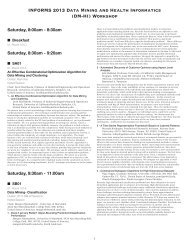
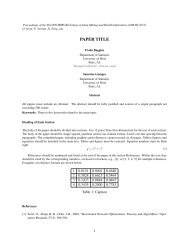
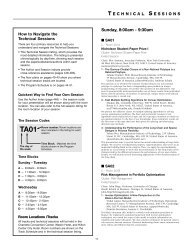
![[PDF] Charlotte Back Matter](https://img.yumpu.com/17933057/1/190x245/pdf-charlotte-back-matter.jpg?quality=85)

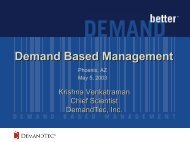
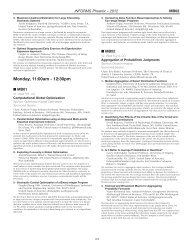
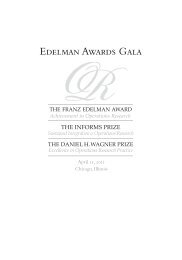
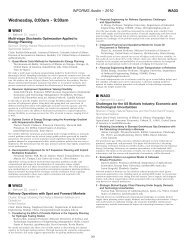
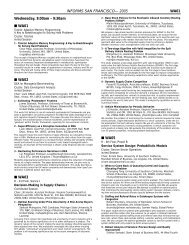
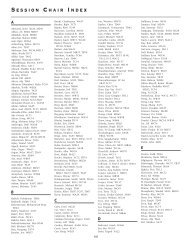
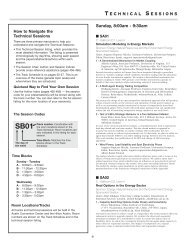
![[PDF] Monday, 8:00am - 9:30am](https://img.yumpu.com/17932954/1/190x245/pdf-monday-800am-930am.jpg?quality=85)
